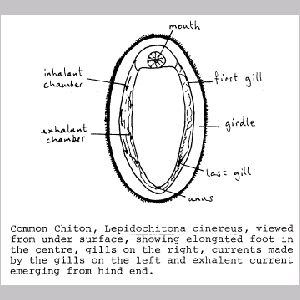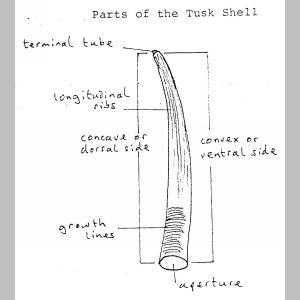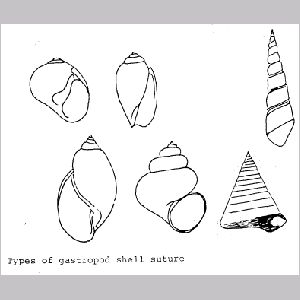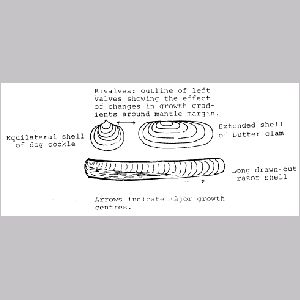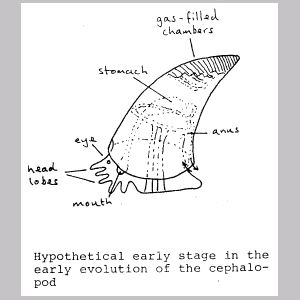Bulletin 35 - July 1988: Marine Mollusks and the Arabian Peninsula
Marine Mollusks and the Arabian Peninsula
By Stephane PrasThe marine fauna of Arabia is related to the great Indo-Pacific province and, although some endemic species can be found along its coast, most of them have a wider range, sometimes extending to the Philippines, Australia or South Africa. The fauna on the Gulf of Oman coast is quite typical of the Indian Ocean and many of its species can also be found easily in Pakistan, India or East Africa. The shoreline offers several kinds of habitat, mainly long, sandy beaches, rocky outcrops, and coral patches. There are too some mangrove areas, more so in Oman than in the UAE. Each species belongs to a particular habitat and cannot live in a different one. During the ENHG visit to Oman earlier this year, time was too short to permit free field study, but we had a very interesting trip to the natural history museum where we met K. Smythe, a distinguished malacologist, and M. Gallagher who, besides his main interest in birds, has collected some marine specimens new to science at Masirah Island, south of Muscat. The sole mollusks we were able to spot there were some land and freshwater snails in the palm groves. The freshwater snails belong to the families Thiaridae and Limnaeidae. They live in streams and ponds among palm trees, and even in Tanuf water duct. Their relative abundance testifies that Omani streams are yet free of pollution, fertilizers and insecticides. The little cylindrical land snails found in many places are Enidae. It is interesting to note that both kinds of snails can be found embedded in mud bricks of old villages, picked up with the mud at the time of building the walls.
The Arabian Peninsula has been more rainy in the past and its actual snail fauna is a relict one, consisting of few species, barely surviving in often-isolated areas. They are scarcer in the UAE than in Oman, where the Indian Ocean brings some rains that never cross the mountains to the Gulf. It is therefore very important to locate and record every settlement, and I would like to ask anybody who has the opportunity of finding specimens while out on a picnic or a trip to do so and inform the Recorder. Museums and research centers are looking for such findings, and some interesting work has been done on relict snail species in Sinai, but not yet in our part of Arabia.
Coastal mollusks specialize in their habitats. Sand dwellers dig into sand for protection. Bivalves remain embedded, with only long siphons reaching the surface to breathe and feed, the animal filtering the incoming water flow for edible zoo- and phytoplankton, which is directed to its mouth. Gastropods remain buried when resting, and move only when looking for food, often at nighttime. Some crawl along the bottom while others, like Natica or Oliva species, crawl just below the surface, progressing rather like a plough but always covered by sand. In both cases, they can easily be spotted by a diver because of the long trail they leave behind. Strombus species graze on algae, Murex chase other mollusks and Cassis eat sea urchins.
Some species are scavengers while others feed on worms or marine invertebrates. The conspicuous Murex scolopax (false Venus comb) lives buried in the sand which is why it is difficult to find, despite its size. Murex and Natica grasp smaller gastropods and bivalves with their muscular foot and drill a little hole in the shell with their radula, a powerful tongue covered with file-like teeth. Then the prey is killed and eaten.
The species living among rocks and coral patches generally cling to a hard surface and hide in cracks and fissures when resting. Bivalves are firmly secured by a strong byssus. These species can be collected by turning up boulders, but remember to replace the stones in exactly the same position, to preserve animals and more importantly the egg masses which are commonly found below both from predators and from sunlight. Some species inhabiting rocky areas prefer to dig in sandy patches around the boulders, and can be found only in this type of habitat, as, for instance, some Comus, Mitra and Terebra.
Inter-tidal species deserve a special mention. They can stand hour-long exposure to air and sunlight until the next tide covers them again. Some hide in sand or rock crevices but many, such as Littorina, Nerita and Trochus, just rest on a hard surface. These species have a powerful muscular foot that enables them to cling firmly on to the rocks despite wave shock.
From a zoological standpoint, Mollusk is one of the major divisions of the animal kingdom, called a phylum. There are about 20 of these divisions, the most familiar to the layman being Vertebrates, Mollusk, Arthropods (insects, spiders, crustaceans and others), Echinoderms (sea urchins and starfish) and Cnidaria (jellyfish, sea anemones and corals). Other phyla are less easy to describe unless one has good knowledge of the invertebrate fauna. The phylum Vertebrates is divided into five well-known classes: fish, amphibians, reptiles, birds and mammals. In the same manner, the phylum Mollusk is split into seven classes: gastropod, scaphopoda, bivalvia, cephalopoda and chitons. I will not say a word of the other two for fear of frightening ENHG members who could still be interested in Mollusk up till now. Gastropod are familiar to everybody. Most of them have coiled shells (except limpets) and thrive at sea, in freshwater or on land, where they are termed snails. Some have no shell at all and are called slugs on land, sea slugs at sea. Bivalvia also live in seawater and freshwater and are more popular than Gastropod among gastronomists. Scaphoda are often overlooked, although they are quite common on some sandy and muddy beaches. They look like a small elephant tusk and their size, depending on species, varies from a few millimeters to about 15 centimeters. Shells up to four centimeters are not uncommon on beaches around Abu Dhabi Island. Chitons are called coat-of-mail shells because of their eight-plate shell that allows them to roll up like terrestrial woodlice when dislodged from the rocks they live on. These are very common on offshore islands in the Gulf. The species inhabiting Dibba and Khor Fakkan cliffs is five to 10 centimeters long, and is common in the inter-tidal zone.
People are not used to thinking of Cephalopoda as mollusks, but they belong indeed to this phylum and are its most evolved representatives. The actual living forms are the shell-less octopus, the squid and the cuttlefish, which retains a backbone structure, anatomically strictly equivalent to the usual shells of their relatives. But few beachcombers realize that the cuttlefish bone is a mollusk shell. Nautilus, a living fossil of tropical waters, has a chambered shell, which is a shelter and a buoy at the same time, the empty chambers being full of gas. In the past (Paleozoic and Mesozoic times) the shelled Cephaloda were very widespread and represented by related forms like Goniatites and Ammonites, both well-known fossil hunting items. Nowadays, Cephaloda have well-developed brains, eyes almost as efficient as those of vertebrates, and are very swift predators. Squid rely for their quick motions on giant nervous cells, the study of which has been useful to physiologists in understanding nervous impulse transfer. They make use of jet propulsion, directing a powerful water flow with a funnel-like structure, in the opposite direction to the desired motion. These successful animals, which have evolved under the pressure of competition with fish, are hampered by their blue blood; the pigment fixing oxygen in their blood cells is haemocyanin, less efficient than the hemoglobin of vertebrates.
What, then, is the reason why such different animals are kept together within a phylum? The idea is that animals, even if they look quite different at first glance, should be related and should stem from a common ancestor, lost in poorly known pre-Cambrian times, more than 600-million years ago, if they share a common basic structure or anatomical organization scheme. This ancestral scheme is fairly easy to define for Vertegrates (a backbone acting as an endoskeleton) or for Arthropods (an articulated carapace protecting the body and acting as an exoskeleton). The question is a bit trickier for Mollusk, but finally scientists have agreed on the following three features:
- The cephalopodium, a muscular mass enabling the animal to move, with brain and sensorial organs at the front end, which evolved into a foot for Gastropod and Bivalvia, or into tentacles and funnel for Cephalopodia;
- The viscera on top of the cephalopodium (mainly digestive tract, liver and gonads); and
- The mantle, or pallium, which is the most original feature of Mollusk. This is a muscular fold enveloping the body of the animal. On the inner side, it defines a palleal cavity containing the gills and the outlets of the reproductive and excretory ducts. It often extends into an inhalant and exhalant siphon, monitoring water flow to the gills. For land snails, the strongly vascularized palleal cavity acts as a lung. It is the outer side of the mantle that produces the shell, by secretion.
All these thorough anatomical studies have led malacologists to imagine what the ancestral mollusk might have been. The consensus is that it was a sort of limpet-like creature that perhaps itself evolved from a segmented worm. It is interesting to compare the evolution of Mollusk with that of Vertebrates. In the Paleozoic, Mollusk were already as widespread in the oceans as Gastropod, Bivalvia and Nautiloid or Ammonitoid Cephalopoda, when fish arose. Snails graduated to land, as did the amphibians. When mammal-like reptiles appeared in Permian times, all Mollusk classes already existed, whereas birds were still to come in the late Cenozoic. And after the final extinction of the dinosaurs, when the first modern mammals appeared on land during the Eocene, some 50-million years ago, the London and Paris basins were submerged by shallow tropical waters, where mollusk species similar to present-day Indo-Pacific ones were already thriving. It means that little mollusk evolution occurred over the time span during which the complete story of modern mammals took place, including the birth and doom of now almost forgotten mammal groups. Due to continental drift, some ancient snail families are presently very widespread in some quite remote parts of the world. The original and conspicuous Clausilidae, for instance, live in South America, around the Mediterranean and in the Far East.
The lower rank classification of Mollusk, namely inside classes, from order to species level, relies heavily on conchological characters. The shell indeed is the easiest part of a mollusk to preserve, and the only part available for fossil species. The shell-based classification was the first one, and is consistent for living and fossil species. It was elaborated at most for Bivalvia, taking into account especially the shape and number of teeth in the valve hinge. Nowadays malacologists pay more and more attention to anatomy and physiology, to the extent that they can use for study complete animals preserved in formalin or alcohol. The main divisions for Gastropod, and most of the classification for land snails, for instance, are now based on anatomical features. The structure of radula (tongue-like organs fitted with rows of teeth) for Gastropod, and the gill structure of Bivalvia, have taken on new importance, and often lead to conclusions different from those arrived at previously by shell study only.
The shell, in fact, is not so typical of Mollusk, since slugs, octopuses and some others are devoid of it, whereas some other living forms possess one. I should now answer some of the questions I am often asked about what a mollusk shell really is and what it is not. I will just point out that the following hard objects to be found on the seashore are not Mollusk: corals, crabs, lobster, sea urchins, brachypods (very confusing, but most probably nobody has seen one), worm tubes, turtles, eggs, coconuts, beer cans and light bulbs. Hermit crabs that inhabit empty shells are only squatters; they move from larger to larger homes while growing.
The way Mollusk breed varies among species. The most primitive ones, and the sessile forms such as Bivalvia, shed male and female gametes in water, and fertilization occurs when they happen to meet in the sea. Cephalopods and Gastropod are fond of internal fecundity, and many sea slugs and land snails are hermaphroditic. Crepidula (slipper shells) begin life as a male and turn into females later. One can hardly imagine what life would like if women existed only after the age of 45. However, in most cases, a free-swimming larva, called a yeliger, hatches from an egg and drifts for a while with plankton before falling to the bottom. Such a process spreads the species, but relies on chance for settlement on suitable ground. The yeliger larva already has an embryonic shell, called a protoconch in the case of Gastropod. Of course, land snails hatch directly as a crawling snail, but some marine species, such as Voluta, do too, which results in a restricted species range.
The growth of the shell is continuous for many species, and whereas the axial cording is merely ornamentation, the ridges or marks parallel to the shell rim are due to changes in the growth rate. Some species, like Cymatium or Murex, grow in steps, adding two-thirds of a whorl at a time. Some other species have a juvenile shell growing continuously and, on maturity, produce the adult shell that does not grow any more but becomes heavier with age. This is the case in cowries, and for species with a wide flaring lip, such as Strombus. The glossy shells of Cowries, Olivas and Marginellas are permanently covered by the mantle when the creature is extended, which protects and maintains the gloss. Most species conversely are covered by a horny periostracum on which marine growth develops and which must be removed by bleach to get a clean specimen for display. The shell itself is made of limestone crystals (calcite or aragonite) embedded in an organic keratinic material called conchyolin. Mother of pearl is made of thin parallel layers of crystals, able to reflect all the rainbow colors by light diffraction.
The Arabian Gulf, on which Abu Dhabi lies, is a shallow water body, with the bottom sloping gradually down from Arabia towards Iran. Water depth is around 40 meters, barely reaching twice this depth along the Iranian coastline. It is quite different from the Red Sea, a rift between Africa and Arabia, over 1 000 meters deep, the edges of which are continuously drifting apart. This is the first reason why the ecology of the two bodies of water is so different. In summertime, water temperatures rise in the Gulf, without the cooling effect of deep layers. Moreover, salinity is low in the north, due to the Tigris and Euphrates rivers, and rather higher towards the south, due to evaporation. The Arabian coast, with sand, silts and sabkha, does not offer much in the way of rocky shorelines. Many species have been recorded from the Gulf, but the populations are scattered and shell collecting is not as rewarding as along the fringes of the Indian Ocean.
I hope this brief overview of Mollusk will help ENHG members to have better understanding of the shell and of the animal that built it. They collection in the Old Fort in Abu Dhabi is incomplete and any contribution of good quality shells would be helpful.

